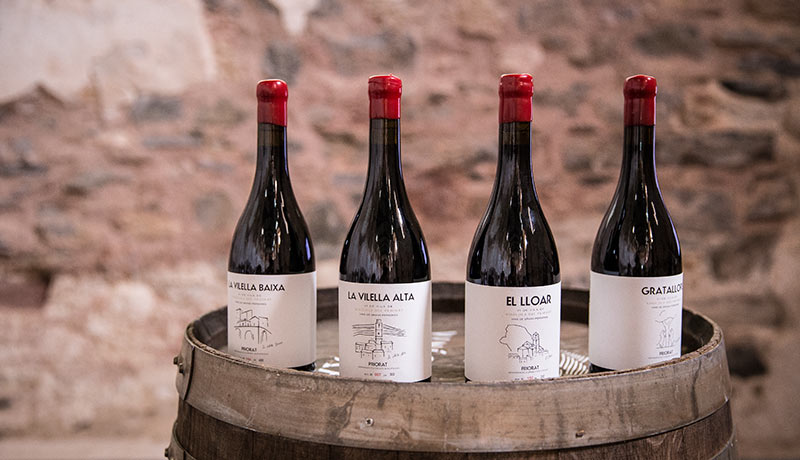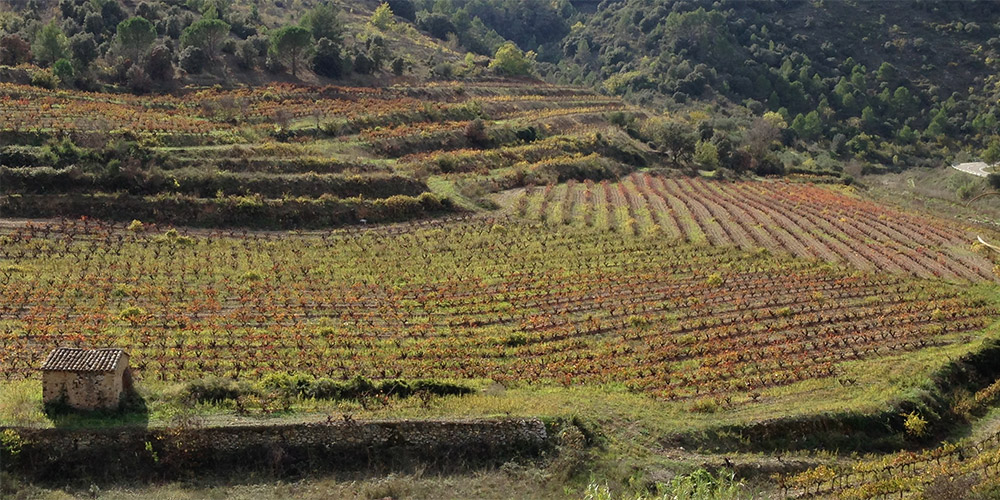Clos 93 is one of those cellars in DOQ Priorat that exemplifies how the winemakers in this appellation are more closely resembling those in Burgundy than anywhere else in Spain. With just 12,000 bottles a year in production and a fully family-run affair in the tiny village of El Lloar, they’ve been able to focus on making very small-production wines from their vineyards that rest up against the Rogerals bluffs of the Montsant massif.
Rubén Sabaté and his brother Josep Maria released their first wine, l’Interrogant (?) in 2011. It’s a very approachable, easy-to-drink wine with an attractive price point that’s a blend of Carignan, Grenache, and Cabernet Sauvignon. Naturally, given the theme of punctuation marks, the next wine they released was l’Exclamació (!) which is 100% Syrah. It sees time in the barrel thus adding both complexity and a natural progression of character.
While working on these wines, they’ve been toiling away on more personal and much, much smaller production wine that has just been released called, Garnatxa del Po. It’s something of a curiosity given that it came about purely by viticultural chance.
An uncle of Rubén and Josep Maria, prior to their starting Clos 93, had been selling his grapes to the local cooperative. When the Grenache from one small, 60 year-old plot arrived from the vineyard, it was quite clear that it was ‘different’. They would run the analysis of the sugar in these grapes and it would come out considerably lower than the other grapes, usually around 13% in potential alcohol versus 15% or more in regular Grenache. The color was inky black and in the mouth, it held a massive degree of structure. These were obviously different grapes than regular Grenache, but how?
As was often the case in the days passed, when people planted vineyards, it wasn’t as scientific as it is now and you’d find a random White or Hairy Grenache vine in a Red Grenache vineyard or even Carignan. This was all put together as a “field blend” in the past and honestly, the small quantities of these random grapes usually made little difference in the end. In modern times however, we select the grapes very carefully during harvest to control the winemaking process.
Garnatxa del Po is a rather obscure clone of Grenache that can be found randomly in vineyards thought to be fully Grenache and it’s this variant that they discovered they had. It’s an antique clone that was apparently mentioned in texts of the monks of the Cartoixa and the name is indeed officially recorded with Incavi although no one is fully sure of where this name came from originally. Rubén explained that it’s not believed to be derived from “por” for “fear” in Catalan. It could be named after a house in Gratallops called, Cal Po whose descendants originally came from France but these are all just guesses.
Their specific plot was something special, though, as no one had ever discovered an entire vineyard, even a small one like this of just 200 vines, that was all Garnatxa del Po. Due to this, the brothers and their uncle have used it as an opportunity to analyze this clonal variant. Incavi and DOQ Priroat are studying the grapes and the vines through genetic as well as cultivation tests. These studies were started in 2013 and will be finished in 2020.
In the present day of 2016, they’ve released the first vintage from 2013 of this wine, all 118 bottles of it. As it’s a unique grape, Rubén has chosen a unique winemaking practice for it. They use no oak barrels and do all stages of alcoholic fermentation and malolactic conversion in stainless steel. While this method of production is quite typical of large production wines, Clos 93 do it to purposefully with this micro production wine to avoid masking the innate characteristics of these grapes.
From the tank, it’s directly bottled and then aged in a tranche of clay in the vineyard for two years. Why? Rubén has done several tastings comparing wines that are aged normally in the cellar and those that are aged underground and found that he liked what he found with the subterranean aging. As a side note, there are winemakers such as Dic Duran with Trosset in Priorat and Ton Rimbau in Penedès who are aging their bottles underwater for the same reasons and from what I’ve personally observed in side by side tastings, it does indeed create a different and at times more complex wine due to the environmental isolation.
The big question most people probably wonder is, how does this very rare wine taste? The simple answer is, unlike any other Grenache you’ve tried. Whether this will speak to you or not depends greatly on your personal tastes, but they have indeed made a unique wine from this rare clone.
I found that visually, the wine presents itself with a deep, deep purple coloration that crests with a ruby rim. Given the medium viscosity, you might think it a wine based mostly upon Syrah due to the incredibly deep color. Aromatically, light young plum notes waft from it along with charcoal notes, typical of carbonic maceration and then a clay minerality which is surprising given that the soil is llicorella-based. But, this is unsurprising given it is typical of the character you find in the flatter, southern villages of DOQ Priorat.
Wild spiciness emerges with touches of black pepper and cloves. It is initially light on the palate with medium acidity, but is bounding in massive, crazy amounts of tannin for a Grenache. It’s very full in the mouth with a medium plus body, but then a medium finish. This is a wine that will easily stand to bottle age another 3-5 years to fully round out and integrate. At three years old, it’s truly just a baby.
Given the small release and the unique qualities of the wine, they decided to release it in a singular manner with a box made of clay from a local ceramicist in Gratallops, Lluís Riera. It all makes for an attractive package, albeit, at 89€, this is not a budget wine, even for Priorat. When compared to their other wines at 12€ for l’Interrogant and 24€ for l’Exclamació, it forms a massive jump in their overall range and is the kind of wine reserved for special gifts.
Naturally for those looking to pick up a very unique and rare wine (as a gift for example) this is indeed an interesting option. For me personally, I see it as a project worth observing as the next few years in the Grenache frontier are going to be exciting ones indeed due to discoveries like this old clone as well as people learning how versatile and elegant this grape can be.



